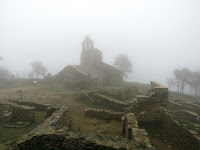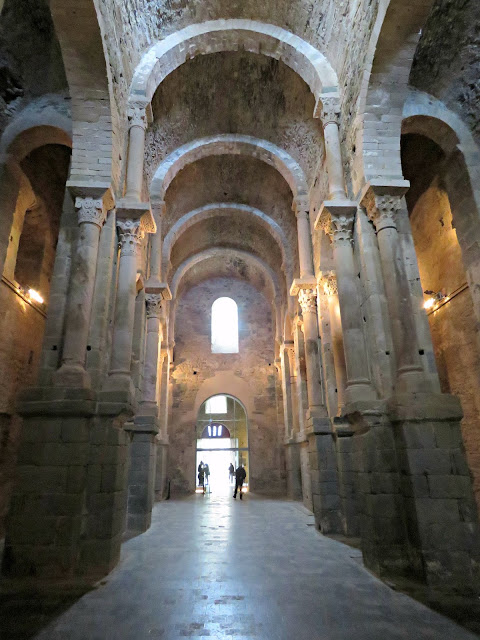According to the legends this is where they took the remains of Saint Peter, the father of the Western Church, after Rome was sacked by the Visigoths in 410 A.D. Rome had fallen to the heathen hordes and the elders of the church wanted to protect their treasures so there was an exodus of precious things such as the mortal remains of the saints, the Relics and the Holy Grail. They were carried off to far flung Christian lands, where the elders prayed they would be safe.
 |
| Sant Pere de Rodes |
I've been wanting to come here for a long time. I'd read about the monastery, and seen some of the artefacts that they'd excavated around it in the Art History Museum in Girona. I was so excited as we drove off, and then so very disappointed by the thick fog that shrouded the Verdera Mountain when we reached Sant Pere. It was a real pea-souper. My weather app had promised me sunshine, and I felt more than a little let down by my technology. Although to be fair there was some splendid sunshine happening down at sea level in nearby Port de la Selva, which is possibly where the weather app had got its intel from.
 |
| A real pea-souper at Sant Pere de Rodes |
 |
| Sant Creu, Sant Pere de Rodes |
 |
| The deserted village and abandoned church of Santa Creu, Sant Pere de Rodes |
They don't really know which came first: this little town or the huge monastery over the hill. The first mention to Santa Creu appears in a Papal Bull of 974 enumerating the territorial possessions of the monastery. Whatever the way of it the fate of the town and monastery were inextricably linked, and they grew - and later declined - in parallel with one another.
 |
| Climbing the Verdera Mountain to Sant Pere de Rodes |
The first mention of monks living up here appears in a document from 878. Back in the day they were a small community, living quietly on their mountain under the protection of the Monastery of Sant Esteve de Banyoles. According to one legend they'd been here since the first century AD. Some (very) early Christians were said to have been ship-wrecked down in the bay below. As a "thank you" for being saved from the sea, they trekked up the mountain and formed a small community.
There is evidence of an early rectangular structure dating from that time on the site, and a number of the marbles used in the monastery church have been dated to the first century AD, suggesting that they've been appropriated from an earlier building.
 |
| Sant Pere de Rodes |
They believe that the present complex was founded by a land-owning noble named Tassius, who died in 955, and whose son, Hildesind became the first Abbot in 947. Before his death Tassius and another noble, Gausfred, the Count of Empúries, endowed Sant Pere with substantial land holdings. They supported the community and used their influence to further its interests. The Frankish King, Louis the Stammerer, was prevailed upon to support its cause, and by 944 a precept had been drawn up establishing Sant Pere as a Benedictine abbey.
 |
| Sant Pere de Rodes |
The monastery reached its zenith in the twelfth and thirteenth centuries. By this time it had grown to become one of the most important centres of spiritual, political and economic power. Many works of art were commissioned, and the complex was extended and embellished to reflect its importance.
 |
| Sant Pere de Rodes |
1348 saw the arrival of the bubonic plague in Europe, which decimated much of the countryside around the abbey. In the aftermath of the plague there were fewer pilgrims, fewer monks and fewer campesinos to work and support the abbey. Further civil unrest and uncertainty followed.
 |
| Sant Pere de Rodes |
The abbey's fortunes never totally recovered. Continued wars with France, especially under the Sun King, Loius XIV, made its remote location more and more difficult to defend and sustain. This part of the world also suffered heavily from pirate attacks, and the abbey was no exception.
Finally in 1798 the Monks gave up the fight, and abandoned their abbey, which slowly but surely fell into disrepair and ruin.
 |
| The church, Sant Pere de Rodes |
But something remains. If you look up at the capitals of the columns in the church that support the roof you can see stonework that looks to my Irish eyes like the Celtic Thread of Life, much used to decorate similar institutions back in my homeland.
 |
| Capital in the church, Sant Pere de Rodes |
They form an eloquent testament to the glory days of the institution when it could afford to commission the finest stone masons, and had the confidence to draw upon disparate influences from far off places to fashion its interior.
If you'd like to come and visit for yourself you can find the website here: Sant Pere de Rodes.
All the best for now,

No comments:
Post a Comment